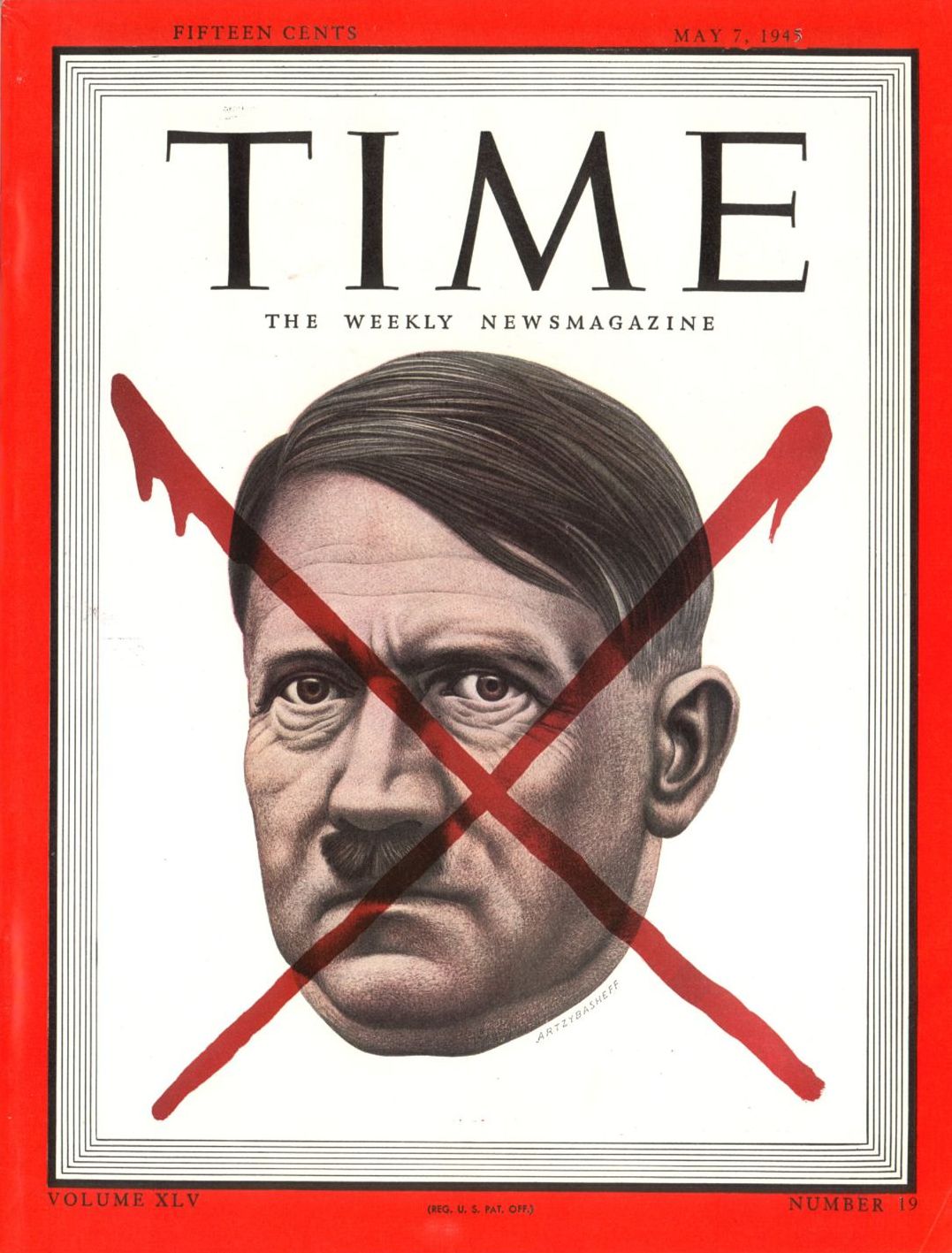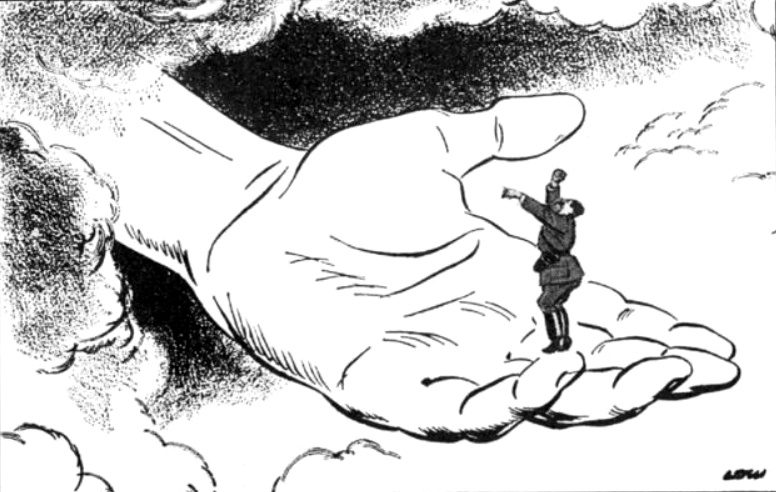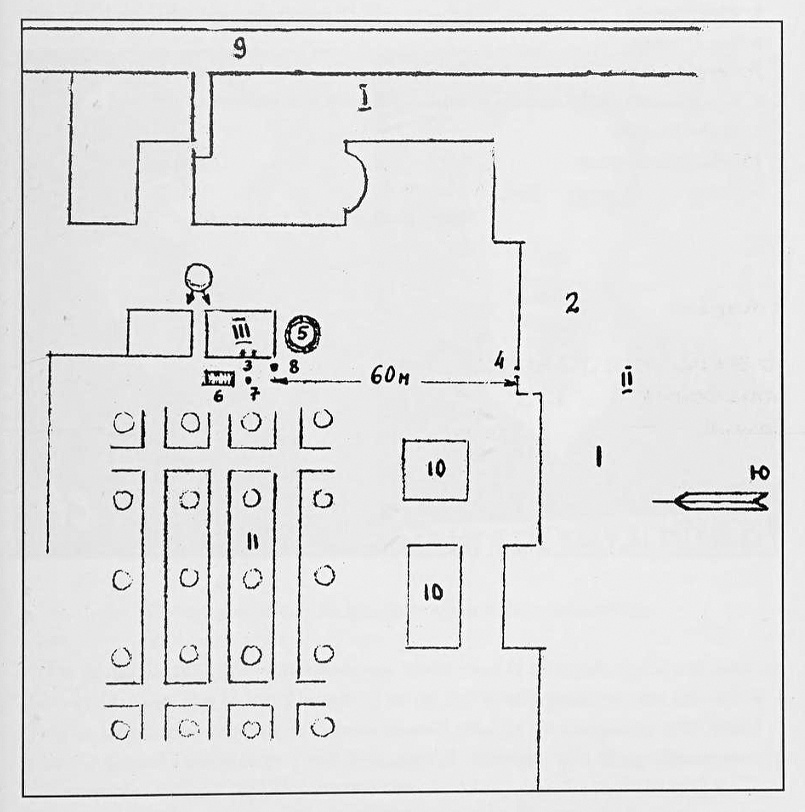АКТ
7 мая 1945 года,
гор. Берлин-Бух, Морг ХПГ 496
Судебно-медицинского исследования трупа овчарки
Комиссия в составе Главного судебно-медицинского эксперта 1-го Белорусского фронта подполковника медицинской службы ШКАРАВСКОГО Ф.И., Главного патолога-анатома Красной Армии подполковника медицинской службы КРАЕВСКОГО К.А., и.о. Главного патолога-анатома 1-го Белорусского фронта майора медицинской службы МАРАНЦ А.Я., армейского судебно-медицинского эксперта 3-й ударной армии майора БОГУСЛАВСКОГО Ю.И. и армейского патолога-анатома 3-й ударной армии майора медицинской службы ГУЛЬКЕВИЧА Ю., по приказанию члена Военного совета 1-го Белорусского фронта генерал-лейтенанта ТЕЛЕГИНА произвела судебно-медицинское исследование трупа овчарки.
При исследовании установлено:
А. Наружный осмотр
Труп крупной собаки (суки), породы немецкой овчарки: окраска шерсти — на спине темно-серая, брюхо — светло-серое. Вокруг пасти черные подпалины. Хвост умеренно пушист. Длина трупа от затылочной кости до начала хвоста — 91 см. Зубы белые, верхушки клыков несколько стертые.
Грудные соски сероватого цвета, хорошо выражены, при сдавливании их выделений не отмечается.
На слизистой языка обнаружено 2 осколка тонкостенной стеклянной ампулы, один из них представляет часть дна ампулы, а другой — стенки.
На слизистой неба небольшие царапины с ровными краями, слизь во рту кровянистая. Вокруг царапин имеются кровоизлияния.
Других повреждений на трупе собаки не обнаружено, длинные кости на ощупь целые.
Б. Внутренний осмотр
Расположение внутренних органов правильное, кровенаполнение умеренное. В сердце и крупных сосудах рыхлые красные кровянистые сгустки.
При вскрытии ощущается ясно выраженный запах горьких миндалей.
Желудочно-кишечный тракт содержит значительное количество полупереваренных пищевых масс с неприятным кислым запахом.
При исследовании внутренних органов видимых болезненных изменений не обнаружено.
Для химического исследования взято 10 кубиков крови и помещено в стеклянную пробирку, а также часть легких, сердца, печени, почек, селезенки, желудка, ки-шек и помещены в стеклянную банку.
Указанные объекты без консервации, направлены во фронтовую санитарную эпидемиологическую лабораторию № 291, для судебно-химического исследования на наличие цианистых соединений и основных ядов…
ЗАКЛЮЧЕНИЕ КОМИССИИ
На основании результатов судебно-медицинского исследования трупа овчарки и судебно-химического исследования ее внутренних органов, комиссия приходит к выводам:
-
Каких-либо повреждений, а также болезненных изменений, которые могли бы вызвать смерть собаки, вскрытием не установлено.
-
В слизистой оболочке пасти и языка обнаружены осколки тонкостенной стеклянной ампулы, при вскрытии трупа ощущался запах горьких миндалей, а судебнохимическим исследованием обнаружено во внутренностях наличие цианистых соединений.
-
Таким образом необходимо сказать, что смерть овчарки наступила в результате отравления цианистыми соединениями.
Комиссия:
Главный судебно-медицинский эксперт 1 БФ
подполковник медицинской службы ШКАРАВСКИЙ
Главный патолог-анатом Красной Армии
подполковник медицинской службы КРАЕВСКИЙ
И.о. Главного патолога-анатома 1 Бел. фронта
майор медицинской службы МАРАНЦ
Судебно-медицинский эксперт 3 ударной армии
майор медицинской службы БОГУСЛАВСКИЙ
Патолог-анатом 3 ударной армии
майор медицинской службы ГУЛЬКЕВИЧ
22 мая 1945 года
Ф. 4 ос, оп. 3, д. 36, л. 40-41 (подлинник)
ПРОТОКОЛ ДОПРОСА ВРАЧА ИМПЕРСКОЙ КАНЦЕЛЯРИИ ГЕЛЬМУТА КУНЦА
1945 года, мая месяца, 7 дня
Начальник 4 отдела Управления контрразведки «Смерш» 1-го Белорусского фронта подполковник ВАСИЛЬЕВ, через переводчика немецкого языка — следователя ст. лейтенанта ВЛАСОВА, допросил военнопленного немецкой армии КУНЦА ГЕЛЬМУТА, 1910 года рождения, уроженца гор. Этлинген, провинции Баден, зубного врача, последнее время работавшего в санитарном управлении СС Берлина в должности адъюнкта при главном зубном враче. Когда санчасть была распущена, перешел работать в госпиталь. 23 апреля госпиталь был вывезен из Берлина, и он был направлен для работы в имперскую канцелярию. В это время там не было зубного врача.
Вопрос: До 23 апреля с.г. вы имели отношение к имперской канцелярии?
Ответ: До этого времени я никакого отношения к имперской канцелярии не имел.
Вопрос: Какое вы имели звание?
Ответ: СС-штурмбанфюрера.
Вопрос: Кого вы лично обслуживали, когда находились при имперской канцелярии?
Ответ: Лично я обслуживал жену ГЕББЕЛЬСА, а впоследствии лечил и солдат, находившихся при имперской канцелярии.
Вопрос: Давно ли вы знаете Геббельса и его семью?
Ответ: С Геббельсом я познакомился 1 мая с.г. [через] его жену. До этого я знал его по выступлениям на парадах. Впервые я видел Геббельса примерно в 1922 году, когда он выступал с речью в народном доме в гор. Вене.
Вопрос: Как же так получилось, что вы не имели доступа в имперскую канцелярию, а 1 мая с.г. вас познакомили с Геббельсом, и сразу же получили широкий доступ в его квартиру?
Ответ: Видимо потому, что я был знаком с женой Геббельса, которую я лечил.
Вопрос: Вы были в квартире Геббельса?
Ответ: Я был в бункере Геббельса в имперской канцелярии, где также проживала его семья — жена и дети.
Вопрос: Какие вам известны физические недостатки у Геббельса, его жены и детей?
Ответ: Жена и дети были совершенно нормальны, а Геббельс хромал на правую ногу.
Вопрос: Уточните более обстоятельно, что произошло с Геббельсом и его семьей.
Ответ: 27 апреля с.г. перед ужином, в 8 — 9 часов вечера я встретил жену Геббельса в коридоре у входа в бункер Гитлера, где она мне заявила, что хочет обратиться ко мне по одному очень важному вопросу, и здесь же добавила: «Сейчас такое положение, что, очевидно, нам придется умереть», — а поэтому просит меня, чтобы я помог умертвить ее детей, на что я дал свое согласие.
После этого разговора жена Геббельса пригласила меня в детскую спальню и показала мне всех своих детей. В это время дети собирались ложиться спать, и я с ними ни с кем не разговаривал.
В тот момент, когда дети уходили спать, зашел сам Геббельс, который пожелал спокойной ночи детям и ушел.
Пробыв в комнате 10 — 15 минут, я попрощался с женой Геббельса и ушел к себе в госпиталь, который располагался там же в бункерах, примерно 500 метров от бункеров Гитлера, Геббельса и других лиц, находившихся при ставке Гитлера.
1 мая с.г., примерно в 4 — 5 часов дня мне в госпиталь позвонила по телефону жена Геббельса, которая заявила, что прошло уже достаточно времени, и просила сейчас же прийти в бункер. После чего я направился к ней, но без всяких медикаментов.
Когда я пришел в бункер Геббельса, то застал в рабочем кабинете самого Геббельса, его жену и государственного секретаря министра пропаганды НАУМАНА, которые о чем-то беседовали.
Обождав у двери кабинета примерно минут 10, когда Геббельс и Науман вышли, жена Геббельса пригласила меня зайти в кабинет и заявила, что решение уже принято (речь шла об умерщвлении детей), т.к. фюрер умер и примерно в 8 — 9 часов вечера части будут пытаться уходить из окружения, а поэтому мы должны умереть. Другого выхода для нас нет.
Во время беседы я предложил жене Геббельса отправить детей в госпиталь и представить их под опеку Красного Креста, на что она не согласилась и заявила: пусть лучше дети умирают…
Минут через 20, в момент нашей беседы в рабочий кабинет вернулся Геббельс, который обратился ко мне со словами: «Доктор, я вам буду очень благодарен, если вы поможете моей жене умертвить детей».
Я Геббельсу также, как и его жене, предложил отправить детей в госпиталь под защиту Красного Креста, на что он ответил: «Это сделать невозможно, ведь все-таки они дети Геббельса».
После этого Геббельс ушел, и я остался с его женой, которая около часа занималась пасьянсом (гадание на картах).
Примерно через час Геббельс снова вернулся вместе с зам. гауляйтера по Берлину ШАХТОМ, и поскольку Шахт, как я понял из их разговора, должен уходить на прорыв с частями немецкой армии, он простился с Геббельсом. Геббельс подарил ему очки в роговой оправе темного цвета со словами: «Возьмите их на память, эти очки носил всегда фюрер». После этого Шахт попрощался с женой Геббельса, а также со мной и ушел.
После ухода Шахта жена Геббельса заявила: «Наши сейчас уходят, русские могут в любую минуту прийти сюда и помешать нам, поэтому нужно торопиться с решением вопроса».
Когда мы, т.е. я и жена Геббельса, вышли из рабочего кабинета, то в передней в этот момент сидели два неизвестных мне военных лица, один в форме «Гитле-рюгенд», форму второго не помню, с которыми Геббельс и его жена стали прощаться, причем неизвестные спросили: «А вы как, господин министр, решили?» Геббельс ничего на это не ответил, а жена заявила: «Гау-ляйтер Берлина и его семья останутся в Берлине и умрут здесь».
Простившись с указанными лицами, Геббельс возвратился к себе в рабочий кабинет, а я вместе с его женой пошли в их квартиру (бункер), где в передней комнате жена Геббельса взяла из шкафа шприц, наполненный морфием, и вручила мне, после чего мы зашли в детскую спальню. В это время дети уже лежали в кроватях, но не спали.
Жена Геббельса объявила детям: «Дети, не пугайтесь, сейчас вам доктор сделает прививку, которую сейчас делают детям и солдатам». С этими словами она вышла из комнаты, а я остался один в комнате и приступил к впрыскиванию морфия, сначала двум старшим девочкам, затем мальчику и остальным девочкам. Впрыскивание делал в руки ниже локтя по 0,5 кубика. Процедура впрыскивания продолжалась примерно 8 —10 минут. После чего я снова вышел в переднюю, где застал жену Геббельса, которой заявил, что нужно обождать минут 10, потом дети заснут, и одновременно я посмотрел на часы — было 20 часов 40 минут (1 мая).
Спустя 10 минут жена Геббельса в сопровождении меня вошла в спальню к детям, где пробыла минут 5, каждому из них вложила в рот по раздавленной ампуле цианистого калия. (Цианистый калий находился в стеклянных ампулах, которые содержали 1,5 куб.) Когда мы вернулись в переднюю, она заявила: «Все кончено». Затем я с ней направился вниз, в рабочий кабинет Геббельса, где застали последнего в очень нервозном состоянии, расхаживающим по комнате. Войдя в кабинет, жена Геббельса заявила: «С детьми все кончено, теперь нам нужно подумать о себе». На что ей Геббельс ответил: «Нужно торопиться, так как у нас мало времени».
Дальше жена Геббельса заявила: «Умирать здесь в подвале не будем», а Геббельс добавил: «Конечно, мы пойдем на улицу, в сад». Жена ему бросила реплику: «Мы пойдем не в сад, а на площадь Вильгельма, где ты всю свою жизнь работал». (Площадь Вильгельма — площадь между зданиями имперского министерства пропаганды и имперской канцелярии.)
Во время беседы Геббельс поблагодарил меня за облегчение их судьбы и, попрощавшись со мной, пожелал успеха в жизни и счастливого пути. После этого я направился к себе в госпиталь (это было примерно в 15-20 минут 10 часа вечера).
Вопрос: Откуда жена Геббельса могла взять отравляющий яд (цианистый калий)?
Ответ: Жена Геббельса мне говорила, что морфий и шприц она получила от второго врача Гитлера — Штумп-фэггера, а где она взяла ампулы с цианистым калием, мне неизвестно.
Вопрос: В момент прощания с Геббельсом, в чем были одеты Геббельс и его жена?
Ответ: В момент прощания с Геббельсом, он был одет в партийную форму — коричневый мундир, черные брюки, обут был в ботинки. На левом рукаве имел простую красную повязку с белым кругом, внутри которого была свастика черного цвета. Был ли на мундире золотой партийный значок, я не утверждаю, так как не помню.
Жена Геббельса была одета в костюм (жакет и юбка) темно-серого цвета в полоску, без головного убора. На левой груди был серебряный значок «Материнский крест», которым награждались матери, имевшие до семи детей. Был ли у нее партийный значок, я не помню.
Я должен добавить, что 24 апреля с.г., когда жена Геббельса была у меня на приеме как у зубного врача, она в личной беседе рассказывала, что у нее имеется еще сын от первого мужа, по фамилии КВАНТ (не точно), который служил в немецкой армии в чине лейтенанта или обер-лейтенанта и, будучи в 1944 году на итальянском фронте, был пленен англо-американскими войсками, затем направлен в Алжир, откуда через Красный Крест установил с семьей Геббельса письменную связь.
Вопрос: Уточните возраст детей Геббельса и в чем они были одеты.
Ответ: Всего детей, умерщвление которых я произвел, было шестеро: пять девочек и один мальчик. Старшей девочке было 12-13 лет, второй девочке 10—12 лет, мальчику 8—10 лет, третьей девочке 6—8 лет, четвертой 4—6 лет и пятой около четырех лет.
Старшая девочка была одета в светло-голубой спальный костюм, состоявший из жакета с короткими рукавами и брюк. Все остальные дети, насколько мне помнится, были одеты в белые ночные рубашки.
Вопрос: От кого и когда вам стало известно о смерти Геббельса и его жены?
Ответ: Об этом мне абсолютно ничего неизвестно.
Вопрос: Уточните, кто из медработников госпиталя был на приеме у Гитлера, когда он награждал их, и каким образом вы туда попали.
Ответ: В ночь с 29 на 30 апреля с.г. я находился в офицерском казино, которое размещалось над бункером Гитлера. Примерно в половине второго по телефону в казино позвонил мне профессор ХААЗЕ, шеф-врач госпиталя, который сообщил, что фюрер приглашает меня и весь медперсонал госпиталя к себе в бункер. Через 20 минут, когда все работники шли в квартиру Гитлера, к ним присоединился и я. В составе этой группы находились:
- Шеф-врач госпиталя — оберштурмфюрер, профессор, доктор ХААЗЕ.
- Ст. врач госпиталя — штандартенфюрер, профессор, доктор ШЕНК.
- Второй врач госпиталя — штурмбангфюрер, доктор КУНЦ.
- Сестра хирургии Эрна ФЛЕГЕЛЬ.
- Сестра хирургии Лизелота ЧЕРВИНСКА.
- Сестра хирургии РУТ (фамилию не знаю).
В коридоре около квартиры фюрера мы остановились, куда к нам минут через 10 вышел сам Гитлер, которому Хаазе представил меня и врача Шенка. После этого от имени награжденных выступила медсестра ЛИНДХОРСТ с короткой речью о преданности фюреру. Гитлер поблагодарил всех награжденных за службу и ушел к себе в кабинет, а мы разошлись по своим местам.
В числе награжденных были: профессор Хаазе — награжден крестом «Кригсфердинст Кройц 1-го класса» (за особые заслуги) и четыре сестры: Эрна Флегель, Лизелота Червинска, Элизабета Линдхорст и Рут (фамилия неизвестна). Они были награждены крестами «Кригсфердинст Кройц 2-го класса», которые были вручены адъютантом Гитлера ГЮН-ШЕ еще в госпитале, до прихода на прием к Гитлеру.
Вопрос: Расскажите подробно о Гитлере, что с ним произошло.
Ответ: О смерти Гитлера впервые я услышал в 9 часов 1 мая, когда части Красной Армии уже окружили Берлин. Я пришел на квартиру Геббельса, жена его плакала и рассказывала, что она стояла на коленях перед Гитлером и просила его не делать этого, а потом добавила: да, но другого выхода не было.
Жена Геббельса ничего определенного не сказала, что сделал Гитлер с собой.
Вопрос: Как же так получается? Вы там все время находились и не знаете обстоятельств смерти Гитлера?
Ответ: В этот момент я не был там и могу говорить только то, что слышал. Тому, что говорила жена Геббельса, я верил. Она говорила, что Германия представляет собой стадо без пастуха, так как Гитлер умер.
Вопрос: Не может быть, чтобы вы не знали, каким образом скончался Гитлер, так как находились при ставке. Требуем, чтобы вы рассказали всю правду.
Ответ: Подробностей смерти Гитлера я не знаю, а рассказываю, что мне было известно от жены Геббельса. Кроме того, среди обслуживающего персонала ходили слухи, что Гитлер покончил жизнь самоубийством, и что труп Гитлера должен быть сожжен в саду имперской канцелярии.
Вопрос: От кого вы слышали, что труп Гитлера должен быть сожжен?
Ответ: Это я слышал от РАТТЕНХУБЕРА, СС-группен-фюрера, который был ответственным за безопасность в ставке фюрера. Он говорил: «Отец оставил нас одних, а теперь мы должны тащить его труп наверх».
Вопрос: Гитлер один покончил жизнь самоубийством, или еще кто?
Ответ: Жизнь самоубийством Гитлер покончил вместе со своей женой БРАУН, на которой он женился за несколько дней до смерти.
Вопрос: Что вы слышали по этому поводу?
Ответ: Мне известен такой случай, что вечером 30 апреля к фрау Браун подбежали дети Геббельса и назвали ее тетя Браун. Она им ответила: теперь я не тетя Браун, а тетя Гитлер. Об этом рассказывала Браун в присутствии врача Хаазе при следующих обстоятельствах: я и профессор Хаазе ужинали, в это время в комнату вошла фрау Браун с детьми. Проходя мимо стола, она обратилась к профессору Хаазе с рассказом, что ее сегодня дети назвали тетя Браун. Она же им ответила, чтобы называли тетя Гитлер.
Вопрос: Откуда вам известно, что Браун должна была покончить жизнь самоубийством вместе с Гитлером?
Ответ: 30 апреля вечером Браун пригласила меня, профессора Хаазе и двух девушек-секретарей фюрера на чашку кофе. Она нам рассказала, что Гитлер написал завещание и что фюрер умрет тогда, когда получит подтверждение, что завещание доставлено тому лицу, которому оно предназначено.
Она также заявила: «Нас все предали — и ГЕРИНГ и ГИММЛЕР, и умереть будет не так трудно, потому что яд уже испытан на собаке, и смерть придет быстро».
Вопрос: Кто испытывал этот яд на собаке?
Ответ: Браун говорила, что уже произвели испытание яда, а кто именно производил испытание, она не говорила.
Вопрос: Вы заявили, что Гитлер за несколько дней до смерти женился на Еве Браун. Уточните, где находилась Браун до замужества и чем она занималась.
Ответ: Со слов группенфюрера Раттенхубера, начальника личной охраны квартиры Гитлера, и личного пилота Гитлера группенфюрера БАУЕРА, мне известно, что до официального замужества Ева Браун находилась при Гитлере. Каких-либо других подробностей о ней я не знаю.
Вопрос: Из каких источников вам стало известно, что Гиммлер должен был вести переговоры с союзниками, и с кем именно?
Ответ: Как я уже показал выше, 30 апреля с.г., между 10 — 11 часами вечера я находился в казино вместе с профессором Хаазе и секретарями Гитлера — фрау ЮНГЕ и КРИСТИАН. Туда зашла жена Гитлера — Ева Гитлер, которая пригласила нас в одну из комнат казино, где мы находились минут 20.
Во время беседы Ева Гитлер нам заявила, что Геринг ненадежный человек, о чем мы всегда знали, что Гиммлер вместо того, чтобы перебросить войска с запада на оборону Берлина, ведет переговоры с союзниками (надо полагать, с Америкой и Англией) о перемирии, без согласия на это Гитлера. Более что-либо подробного по этому вопросу она нам не рассказывала.
Вопрос: Когда и с кем вы выходили из бункера и куда направлялись?
Ответ: Я находился в бункерах госпиталя до двух часов дня 3 мая с.г., то есть до момента пленения. Вместе со мной в госпитале оставались профессор Хаазе, сестры Флегель и Червинска.
Профессор Шенк и сестра по имени Рут (фамилию не знаю) принимали участие в прорыве, и судьба мне их неизвестна.
(Допрос прерывается)
Показания мне зачитаны с переводом на немецкий язык и с моих слов записаны правильно.
КУНЦ
Допросили:
Начальник 4 отдела Управления контрразведки «Смерш» 1-го Белорусского фронта
подполковник ВАСИЛЬЕВ
Переводчик: старший лейтенант ВЛАСОВ
Показания стенографировала
мл. лейтенант м/с ХРУЩЕВА
Арх. Н-21092, л. 12-20 (подлинник)


